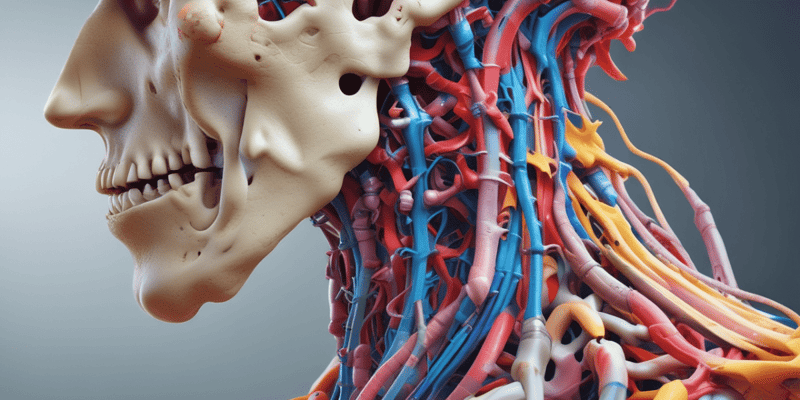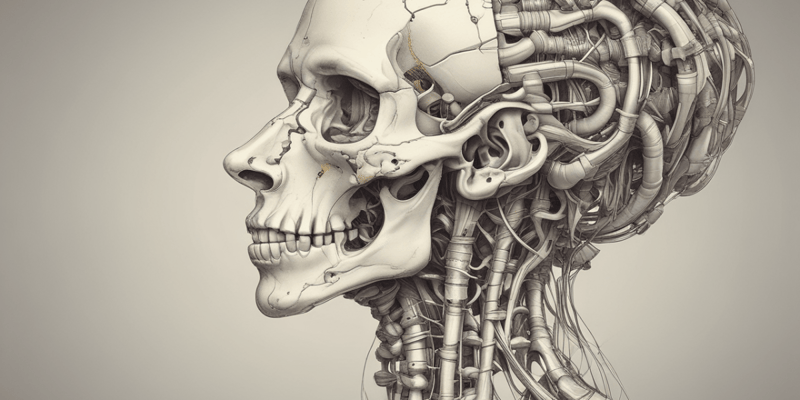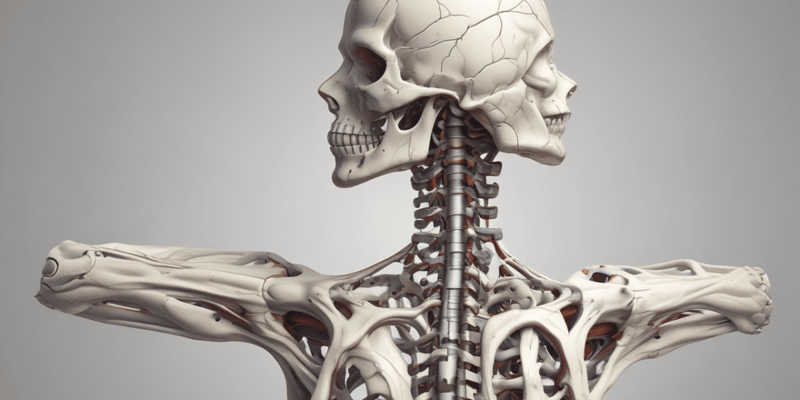Podcast Beta
Questions and Answers
What is the first step in palpating the C7 spinous process?
Which statement is true regarding the movement of C6 compared to C7?
How does the horizontal distance (HD) relate to the cervical spine?
What characteristic describes kyphosis?
Signup and view all the answers
What happens to the cervical spine if the thoracic platform is kyphotic?
Signup and view all the answers
When observing posture, what is indicated by the tilt of the head on the neck?
Signup and view all the answers
What does the observation of vertebral body orientation help to assess?
Signup and view all the answers
Which area of the spine moves more to compensate for reduced motion in another area?
Signup and view all the answers
What feeling indicates that the vertebra is C6 during palpation while assessing neck motion?
Signup and view all the answers
How does the horizontal distance (HD) affect the cervical extensors?
Signup and view all the answers
What is a significant implication of kyphosis on cervical spine alignment?
Signup and view all the answers
What should be done if palpating the C7 spinous process becomes challenging?
Signup and view all the answers
What observation should be made regarding the shoulders when assessing posture?
Signup and view all the answers
Why is it important to assess the tilt of the head on the neck while observing posture?
Signup and view all the answers
How does the curvature of the thoracic spine influence the cervical spine?
Signup and view all the answers
What does the observation of the vertebral body orientation help identify in spinal assessment?
Signup and view all the answers
Study Notes
Palpating C7
- Locate the most prominent vertebra during full neck flexion.
- Palpate the prominent vertebra, then ask the model to perform full neck extension.
- If the vertebra translates anteriorly and becomes less prominent, it is C6.
- C6 is a mobile vertebra; C7 and T1 are less mobile.
- Palpate lower and repeat the process.
- C7 should remain equally prominent during flexion and extension.
EAM & Head Tilt
- The ear-to-acromion distance (EAM) provides an approximation of the center of mass of the head.
- The horizontal distance (HD) between the EAM and cervical vertebra C7 impacts leverage gravity exerts on cervical spine flexion.
- A larger HD results in increased leverage for gravity, requiring greater effort from cervical extensors.
Lateral Flexion
- A line bisecting the center of the neck indicates neutral posture.
- Head tilt to the right indicates lateral flexion to the right.
- The shoulders and head tilt in the same direction during lateral flexion.
Kyphosis
- Kyphosis refers to an excessive convex curvature of the thoracic and sacral regions of the spine.
- Exaggerated kyphosis enhances flexion, leading to a hunched appearance in the upper thoracic spine and a flattened appearance in the lower thoracic region.
- The spine compensates for restricted motion in one area by enhancing movement in another.
Assessing Kyphosis
- Use the palm of your fingers to palpate the thoracic spine to assess curvature.
- A kyphotic curve facilitates cervical flexion, pushing the head forward.
- The thoracic spine serves as a platform for the cervical spine.
- Assess for signs of rotation in the thoracic spine by observing whether one side sits closer to you and determining the direction the vertebral bodies face.
Palpating C7 SP
- To palpate the C7 spinous process (SP), ask the model to perform full neck flexion and feel for the most prominent vertebra.
- Palpate the prominent vertebra and ask the model to perform full neck extension.
- If the vertebra moves forward (anterior translation) and you feel it less, it's C6.
- C6 is a mobile vertebra, while C7 and T1 are less mobile.
- Palpate lower and try again. C7 should feel the same with flexion and extension.
Head Tilt and Cervical Spine
- The ear-to-acromion (EAM) distance provides an approximation of the head's center of mass.
- The horizontal distance (HD) between the EAM and the center of the neck is crucial because a larger HD means gravity has a greater leverage to cause cervical spine flexion.
- A larger HD will require more muscular effort from the cervical extensors.
Lateral Flexion and Cervical Spine
- A line bisecting the center of the neck should be parallel to the line connecting the shoulders.
- If the head is tilted to the right, this indicates lateral flexion.
- The tilt of the head on the neck should be aligned with the shoulders.
Kyphosis and Posture
- Kyphosis is an abnormally excessive convex curvature of the spine, particularly in the thoracic and sacral regions.
- Exaggerated kyphosis can lead to increased flexion of the thoracic spine, resulting in a hunched appearance in the upper half and a flat appearance in the lower half.
- The body compensates for decreased motion in one area by increasing motion in another.
Evaluating Thoracic Spine
- When evaluating curvatures, use the palm of your fingers to palpate for a better feel.
- It's challenging to maintain a neutral cervical spine if the thoracic platform is kyphotic.
- A kyphotic curve makes it easier for the cervical spine to lean into flexion, pushing the head forward.
- The thoracic spine acts as a platform for the cervical spine.
- Look for signs of rotation in the thoracic spine, such as one side sitting closer to you or the vertebral bodies facing a certain direction.
Studying That Suits You
Use AI to generate personalized quizzes and flashcards to suit your learning preferences.
Related Documents
Description
Test your knowledge on the anatomy and movement mechanics of the cervical spine. This quiz covers the palpation of C7, ear-to-acromion distance importance, and concepts related to lateral flexion. Challenge yourself with questions that enhance your understanding of cervical vertebrae and head posture.




